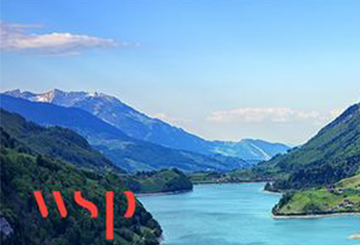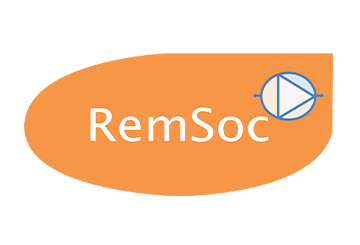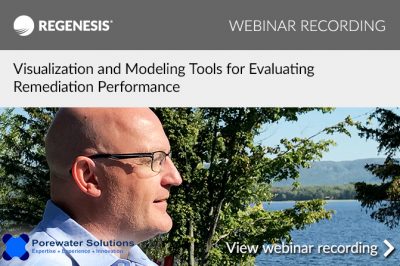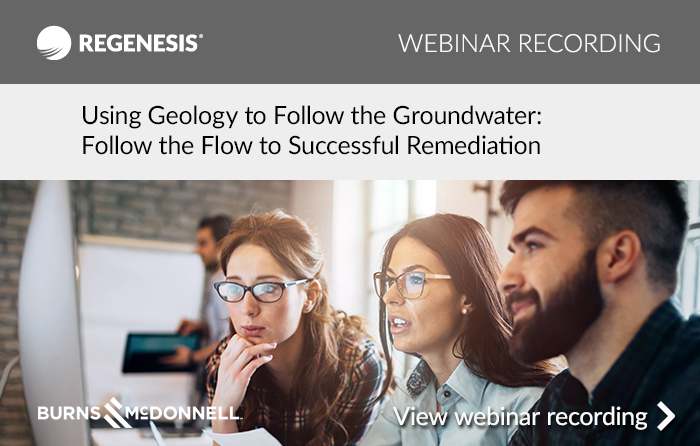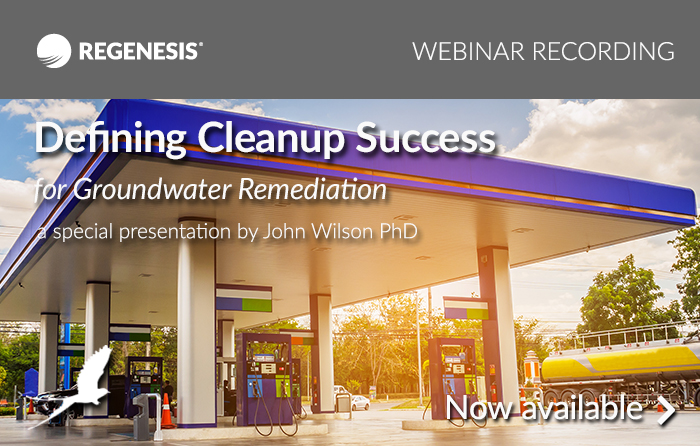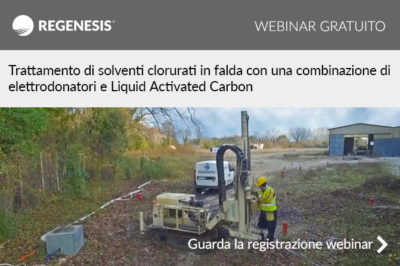Case study: Demonstrating success with PlumeStop and colloidal ZVI – with Matt Burns of WSP
Recording Available| We are pleased to have guest speaker Matt Burns, Senior Fellow at WSP present this live, international webinar. He will present PlumeStop® and colloidal ZVI (cZVI) treatment case studies and practical analytical strategies used to demonstrate destructive treatment.
Stimulating biodegradation of chlorinated VOCs on activated carbon and direct abiotic treatment of using reduced metals such as ZVI are not new to the remediation industry and have proven to be highly effective when direct contact is made. However, the colloidal solid composition of these materials severely limits efficient in situ application at most sites.
The steric stabilization chemistry behind the Regenesis products PlumeStop and cZVI eases delivery challenges and dramatically widens the applicability window of these amendments to include most sites where in situ remediation is contemplated. These transformational amendments bring a unique set of regulatory and performance monitoring challenges when discerning desirable destructive processes from often unacceptable non-destructive mechanisms.
About the Presenter:
About the Presenter:
Matthew Burns, Technical Fellow | U.S. Contaminated Land National Service Line Director, WSP
Matt is a Technical Fellow and the U.S. contaminated land national service line director for WSP with more than 25 years of professional chemistry and engineering experience. He is based in Boston, Massachusetts and is responsible for the financial and technical depth and breadth of the contaminated land (site investigation and remediation) service line. Matt brings chemical and microbial process expertise to assist local WSP teams with challenging investigation and remediation projects in the U.S. and across the globe.
View webinar recording
Caso di studio: Contenimento in situ di PFAS mediante PlumeStop Liquid Activated Carbon
First broadcast: May 22, 2018
Speakers: Marcello Carboni, Mediterranean District Manager
In questo webinar Marcello Carboni, Mediterranean District Manager di REGENESIS, discuterà della capacità del PlumeStop® Liquid Activated Carbon di trattare in modo vantaggioso i composti perfluorurati (PFAS), compresi PFOS e PFOA. Introdurrà le caratteristiche di questi contaminanti complessi, illustrerà come il PlumeStop adsorbe in situ i PFAS, discuterà le strategie di contenimento di plume di perfluorurati mediante barriere di iniezione, e presenterà un caso studio di un sito contaminato da PFAS in Canada che è stato bonificato con successo utilizzando il PlumeStop.
Questo sito, un ex stabilimento industriale di produzione di mobili in cui era presente anche una struttura di addestramento antincendio, era in corso di trattamento per la presenza residuale di idrocarburi petroliferi quando delle ulteriori analisi sulle acque sotterranee hanno indicato la presenza in falda anche di PFOA e PFOS. Utilizzando la metodologia direct push, il PlumeStop è stato iniettato insieme all’ORC Advanced® in 50 postazioni nell’acquifero in sabbia limosa al fine di trattare gli idrocarburi petroliferi.
Le analisi di monitoraggio post-iniezione su un arco temporale di 18 mesi hanno evidenziato che sia gli idrocarburi petroliferi che PFOA e PFOS sono scesi al di sotto dei limiti di rilevabilità strumentale. Sarà inoltre discusso un sito italiano contaminato da PFAS, dove sono attualmente in corso test batch e in colonna prima di procedere ad un’applicazione pilota in campo.
Presentato da: Marcello Carboni
View webinar recording:
Case study: Successful in situ remediation of PFAS using PlumeStop – with Rick McGregor of ISRL
First broadcast: May 16, 2018
Speakers: Rick McGregor President, InSitu Remediation Services Ltd
Recording Available | In this webinar we are pleased to have as a special guest speaker Rick McGregor, President of InSitu Remediation Services Ltd. His presentation discusses the in situ remediation of PFOA and PFOS at a site in eastern Canada using PlumeStop® Liquid Activated Carbon™.
This site, a former industrial furniture manufacturing site where a fire training facility was co-located, was being remediated for residue petroleum hydrocarbons when groundwater testing indicated that PFOA and PFOS was present within the groundwater. Using direct push technology, Liquid Activated Carbon along with ORC Advanced® was injected at 50 locations within the silty sand aquifer to address the petroleum hydrocarbons. Post-injection testing over a one-year period indicated that the petroleum hydrocarbons along with the PFOA and PFOS was attenuated to below the applicable method detection limits.
View webinar recording
From Laboratory to Site: The development and deployment of an innovative Liquid Activated Carbon technology
First broadcast: April 20, 2018
Speakers: Gareth Leonard, Managing Director of REGENESIS Ltd.
Recording Available| RemSoc Early Career Practitioner (ECP) webinar
From Laboratory to Site: The development and deployment of an innovative Liquid Activated Carbon technology
PlumeStop Liquid Activated Carbon has been shown to provide rapid and sustained reductions in dissolved phase contamination and is still a relatively new in situ remediation approach.
In this second webinar for RemSoc aimed at Early Career Practitioners (ECP), we will explain the mechanisms behind this innovative remedial approach, citing laboratory studies used in the development of the technology, field applications from beta- to full-scale sites and ongoing research into the use of the technique.
Please click here for more information on RemSoc.
To become a member of the Early Career Practitioner (EPC) group, please contact Sarah Poulton (Sarah.Poulton@wsp.com).
View webinar recording:
RemSoc Webinar: Enhanced Reductive Dechlorination for the Remediation of Chlorinated Solvents in Groundwater
First broadcast: January 26, 2018
Speakers: Gareth Leonard, Managing Director of REGENESIS Ltd.
Recording Available | On behalf of the Remediation Society (RemSoc), Gareth Leonard of REGENESIS presented this webinar which is aimed at Early Career Professionals. In this presentation, an explanation is given on what Chlorinated Solvents are, including their characteristics in the subsurface. This is followed by a visual explanation of the process of Enhanced Reductive Dechlorination (ERD), and how this process is used in in situ remediation to clean up the contamination in groundwater. This webinar includes graphs, short animations and case studies to explain the processes involved.
Please click here for more information on RemSoc.
To become a member of the Early Career Practitioner (EPC) group, please contact Sarah Poulton (Sarah.Poulton@wsp.com).
View webinar recording
Visualization and Modeling Tools for Evaluating Remediation Performance
First broadcast: October 26, 2017
Speakers: Grant Carey, Ph.D. President, Porewater Solutions and Maureen Dooley Director of Strategic Projects, REGENESIS
In this webinar we are pleased to have as a special guest speaker Grant Carey, Ph.D., President of Porewater Solutions. His presentation will demonstrate visualization and modeling tools which may be used to improve the assessment and communication of site remediation activities. Dr. Carey’s presentation will cover the following visualization and modeling tools:
- Visual Bio™ – A free radial diagram tool with unique modifications that now make it easy to visualize where biodegradation is occurring in groundwater. This visualization tool is well suited for evaluating contaminant and redox indicator trends during natural and enhanced attenuation. The methods and benefits of this approach are illustrated for a data-rich site where enhanced bioremediation was successfully implemented.
- ISR-MT3DMS™ – A reactive transport model which was recently updated to simulate the performance of PlumeStop® Liquid Activated Carbon™. Key features required to model the performance and longevity of PlumeStop are demonstrated for a case study application. The benefits of reactive transport modeling for designing a site remedy are also discussed.
Dr. Carey will be joined by Maureen Dooley, Director of Strategic Projects at REGENESIS, who will share her expertise on remediation of complex sites as it relates to the projects and modeling tools featured in Dr. Carey’s presentation.
View the recording of this free webinar
Using Geology to Follow the Groundwater: Follow the Flow to Successful Remediation
First broadcast: November 15, 2017
Speakers: Rick Cramer, PG, CA Remediation Department Manager at Burns & McDonnell and Craig Sandefur Vice President of Remediation Applications Development at REGENESIS
Recording Available| In this webinar we are pleased to have as a special guest speaker Rick Cramer, CA Remediation Department Manager at Burns & McDonnell(USA). His presentation will demonstrate Environmental Sequence Stratigraphy (ESS), an established methodology that significantly reduces the uncertainty and provides the framework for characterising contaminant migration pathways and defining the conceptual site model (CSM).
Examples will be presented that show the efficacy of ESS as a critical path to complex site investigation and remediation. The methodology has been successfully applied at numerous complex contaminated groundwater sites throughout the US, including over 25 US Department of Defense (DoD) facilities. The case studies will provide examples of best practices in applying geology to CSMs and provide “rules of thumb” to test the efficacy of your CSM.
Certificates of Attendance can be made available (that may contribute to CPD). Please email your request for you and your colleagues to europe@regenesis.com.
View webinar recording
Defining Cleanup Success for Groundwater Remediation
First broadcast: January 16, 2019
Speakers: John Wilson PhD, Principal Scientist at Scissortail Environmental Solutions
In this webinar we are pleased to have a special guest presentation by John Wilson PhD, leading authority on monitored natural attenuation and Principal Scientist at Scissortail Environmental Solutions, LLC. Dr. Wilson poses the question: Do we need a better definition of success for cleanups at sites contaminated with residual NAPL hydrocarbons?
View this Free Webinar
Demonstrating Contaminant Biodegradation in Conjunction with PlumeStop®Liquid Activated Carbon™
First broadcast: July 25, 2017
Speakers: Dora Taggart President, Microbial Insights, Inc.
Recording Available | PlumeStop Liquid Activated Carbon is an innovative remediation technology with the potential to rapidly reduce dissolved contaminant concentrations, decrease risk of migration, and provide a means of addressing contaminant back-diffusion. As is demonstrated in this webinar, the technology permits and promotes biodegradation to achieve not just containment but effective contaminant destruction as a long term solution.
In this webinar we are pleased to have as a special guest speaker Dora Taggart, President of Microbial Insights, Inc. Her presentation focused on case studies where molecular biological tools (qPCR and QuantArray®) were used to investigate the impact of PlumeStop injections on key halorespiring bacteria and anaerobic biodegradation at chlorinated solvent sites. The full recording is now available here.
View webinar recording
Trattamento di solventi clorurati in falda con una combinazione di elettrodonatori e Liquid Activated Carbon
First broadcast: July 17, 2017
Speakers: Marcello Carboni (Mediterranean District Manager) and Paola Goria (Technical Service Manager)
Questo webinar è stato presentato in diretta il 12 luglio 2017. L’Ing. Marcello Carboni e l’Ing. Paola Goria hanno presentato un caso di studio italiano relativo ad un sito complesso di grandi dimensioni con una contaminazione da solventi clorurati nell’acquifero superficiale.
Il progetto è stato modulato per fasi, di cui la prima è consistita in un intervento di biodegradazione anaerobica potenziata mediante l’utilizzo di elettrodonatori con caratteristiche differenti tra loro (3-D Microemulsion® e prodotti della famiglia HRC®) in funzione delle diverse condizioni delle aree di trattamento.
La seconda fase, di cui è stata realizzata una prova pilota in campo e il cui intervento full scale è attualmente in fase di definizione, consiste in un processo di adsorbimento in situ mediante l’innovativo PlumeStop® Liquid Activated Carbon™, finalizzato al raggiungimento di CSC particolarmente restrittive sul confine di proprietà.

 Americas
Americas Europe
Europe Français
Français Deutsch
Deutsch Italiano
Italiano Español
Español